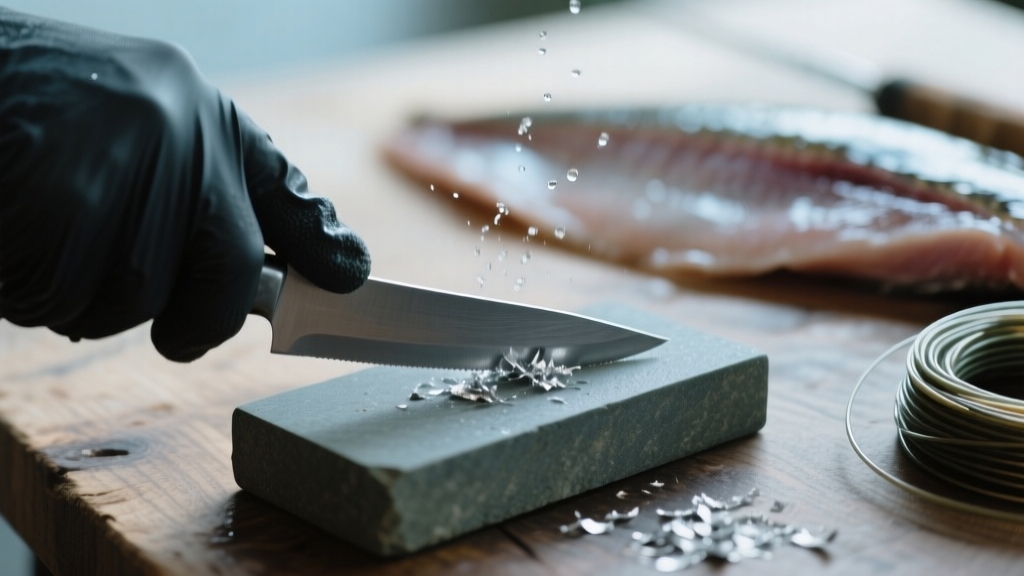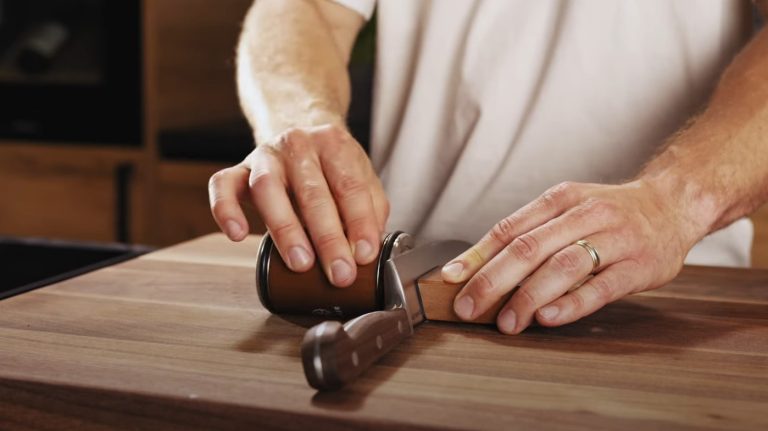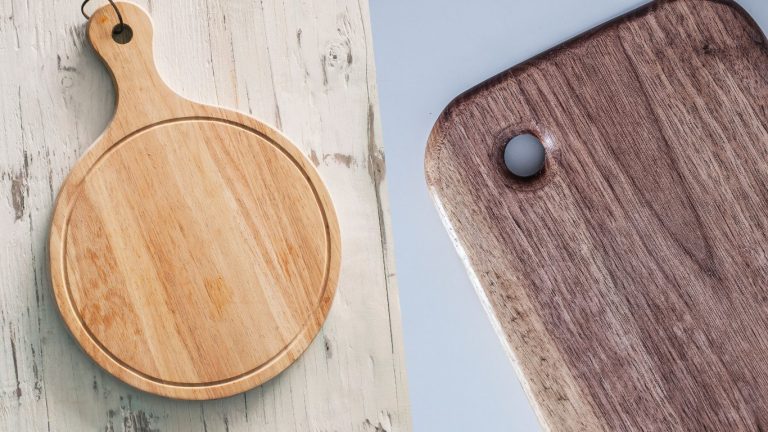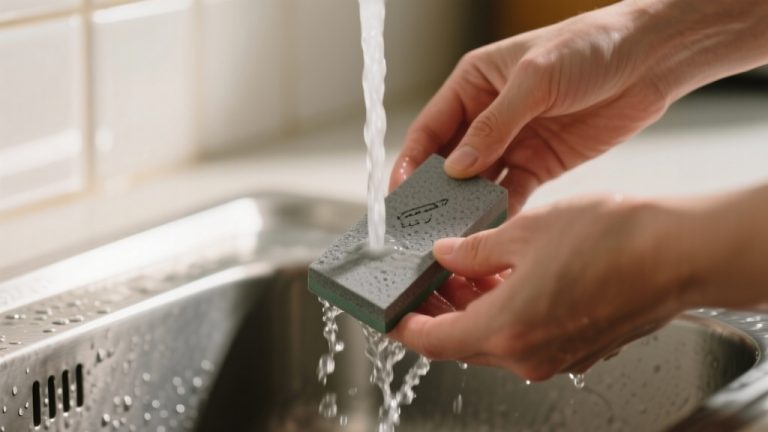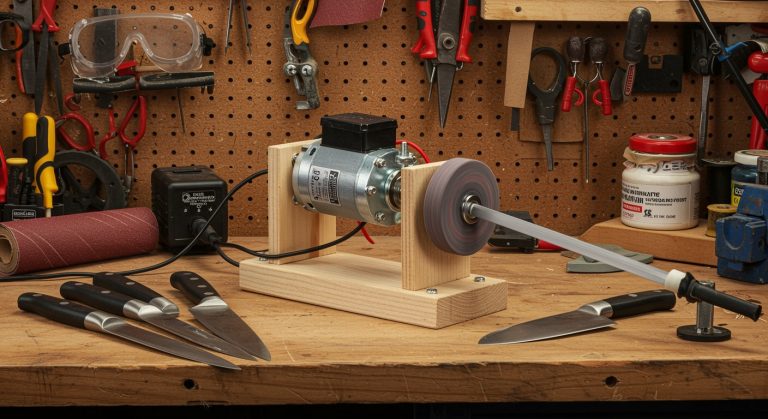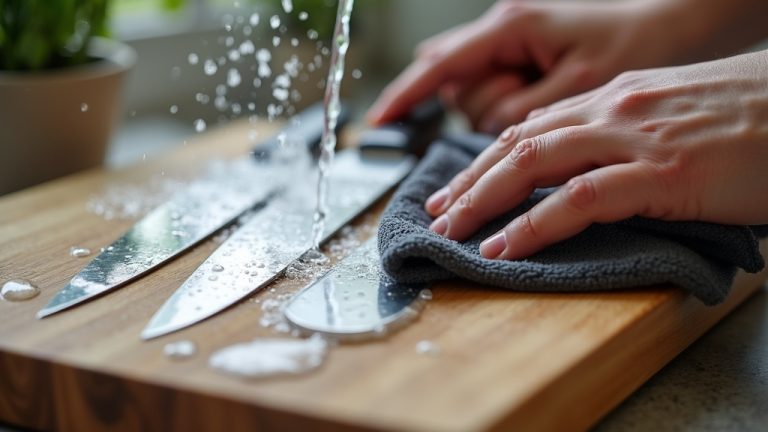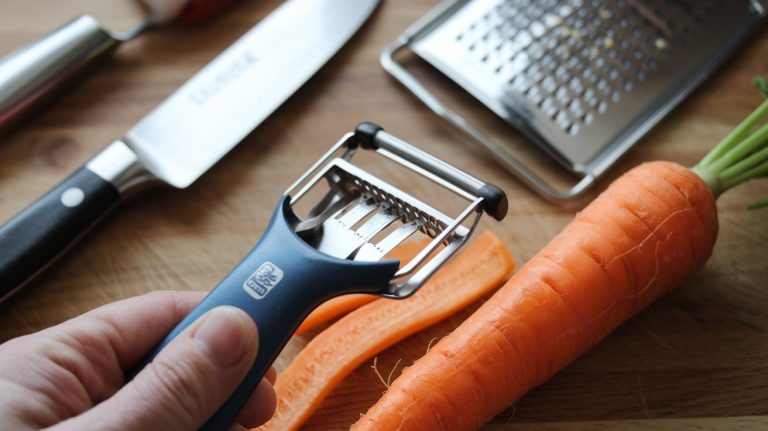Best Way to Sharpen Fillet Knife: Keep Your Blade Like New
To sharpen your fillet knife effectively, maintain a consistent 20-degree angle and start with a coarse grit to reshape the edge.
Then move to finer grits for refinement. Alternate strokes on each side to guarantee symmetry and form a burr, which you should remove with light strokes on finer stones or a leather strop.
Use a stable surface and proper lubrication to avoid overheating. Proper technique and routine care will keep your blade sharp and flexible.
Exploring these details ensures your knife performs at its best longer.
Key Takeaways
- Use fine-grit sharpening stones (water or diamond) to maintain the delicate edge of fillet knives without removing excessive metal.
- Maintain a consistent sharpening angle around 20° for precise edge control and optimal cutting performance.
- Alternate sharpening strokes evenly on both sides to create a balanced, sharp edge and prevent uneven wear.
- Remove burrs carefully with finer grits or leather strops to improve edge sharpness and durability.
- Regularly hone and clean the knife after sharpening to preserve sharpness and prevent rust or corrosion.
Choosing the Ideal Sharpening Tools for Fillet Knives
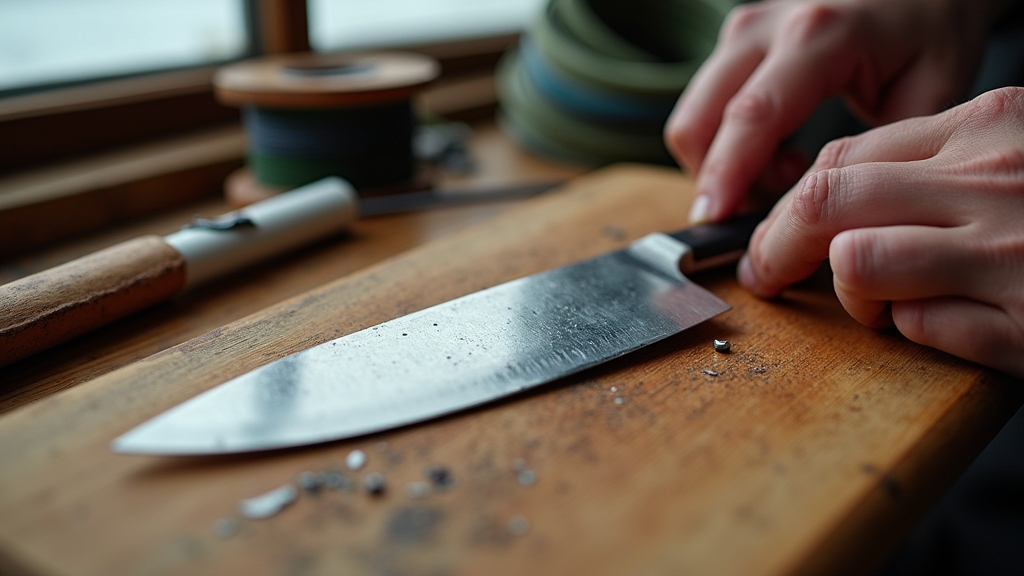
When choosing the ideal sharpening tools for your fillet knife, you need to balance convenience, precision, and budget.
Electric sharpeners like the Chef’s Choice 312 and Work Sharp Ken Onion Edition offer fast, consistent results and ease of use. They’re ideal if you want quick sharpening with minimal effort.
Manual options, such as the Horl 2 Oak Rolling Sharpener or Smith’s Adjustable Angle 2-Stage Sharpener, give you greater control over the sharpening angle. They often come at a lower cost, though they require more skill.
Consider key features like adjustable angles, two-stage sharpening, portability, and maintenance needs.
For a simple, budget-friendly tool, the AccuSharp Knife & Tool Sharpener provides quick, straightforward sharpening.
Your choice depends on how much control, speed, and versatility you prioritize.
Additionally, regular use of a handheld sharpener with coarse and fine slots can help maintain the knife’s edge between more intensive sharpenings.
Understanding the Proper Sharpening Angle
Although sharpening angles vary, understanding the proper angle for your fillet knife is essential to maintaining its performance and durability. Typically, fillet knives sharpen between 12.5° and 25°, balancing precision and edge strength.
Choosing the right angle depends largely on the intended use and blade material, as different angles affect sharpness and durability. Flexible blades need higher angles (20°-25°) to prevent chipping. A mid-range angle (~18°) offers balanced sharpness.
It is important to remember that steel composition significantly influences the choice of sharpening angle to maximize edge stability.
| Angle Range | Purpose | Recommended Use |
|---|---|---|
| 12.5° | Precision cuts | Light filleting, delicate work |
| 18° | Balanced sharpness | Most general fillet knives |
| 20°-25° | Durability & chip resistance | Flexible blades, tougher use |
| Existing Edge Angle | Consistency | Match original edge angle |
| Manufacturer Guidance | Specific tools | Follow system recommendations |
Preparing Your Workstation for Sharpening
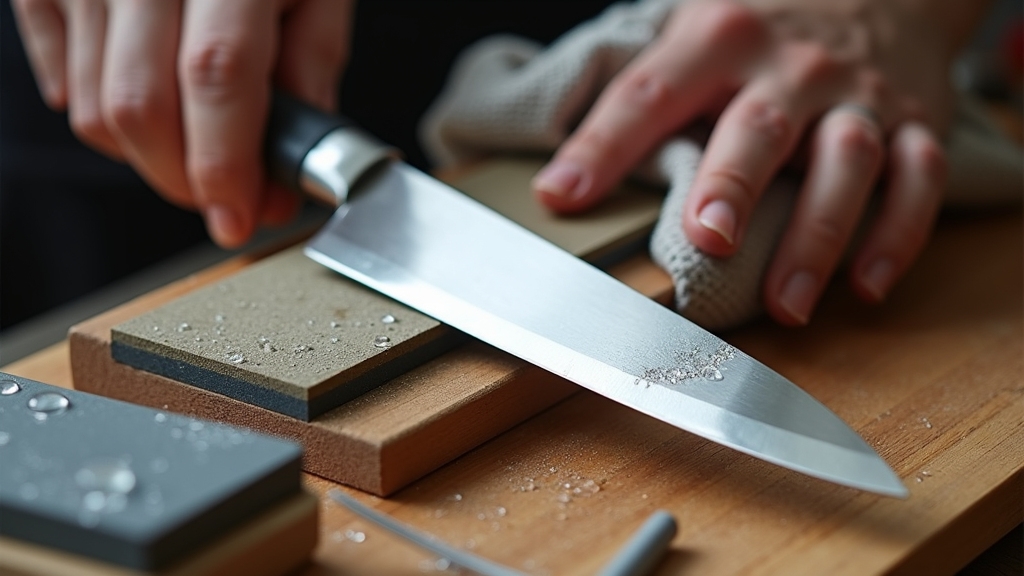
Let’s kick things off by finding a solid surface for sharpening. You want something stable that won’t move around while you’re working. This is super important for both safety and keeping your control over the blade.
Next, it’s time to gather your tools. Get your stones, guides, and lubricants all together. You’ll want everything within arm’s reach so you can keep your workflow smooth and efficient. Remember, maintaining a consistent sharpening angle of around 20° is crucial for achieving the best edge. Regular sharpening is crucial for optimal knife performance and longevity.
And don’t forget about lighting! Good lighting is key. You need to be able to see the blade edge clearly to maintain that perfect sharpening angle throughout the whole process. Trust me, it makes a world of difference!
Choose Stable Surface
Since a stable surface forms the foundation of safe and effective sharpening, you must select one that won’t shift or wobble during use. A solid countertop or sturdy workbench works best. Ensuring stability also helps you maintain a consistent blade angle throughout the sharpening process.
To further prevent movement, use a non-slip base or mat under your sharpening stone. This steadiness ensures consistent blade contact and reduces accident risk. Proper lighting also matters; position your workspace where you can clearly see the blade’s edge. Regular maintenance and sharpening safety precautions should also be observed to avoid injury.
| Factor | Recommendation |
|---|---|
| Surface | Solid countertop or workbench |
| Stability Aid | Non-slip base or mat |
| Lighting | Bright, direct illumination |
Gather Necessary Tools
Before you begin sharpening your fillet knife, gather all necessary tools and supplies to streamline the process and guarantee safety.
Select a sharpener designed for fillet knives, such as a two-stage carbide and ceramic sharpener or a diamond-honed tungsten carbide model. If possible, choose one with ergonomic handles for better control.
Prepare ancillary supplies like water or honing oil for whetstones, a leather strop for polishing, and a clean cloth to wipe the blade. Consider using a handheld sharpener with a soft grip handle for comfortable use during the sharpening process. It’s also helpful to understand the advantages of using a DC motor sharpener for consistent sharpening results.
Organize your workstation by placing everything within easy reach on a non-slip surface and clear space to maneuver the knife and sharpener.
Ensure Proper Lighting
Although sharpening a fillet knife demands steady hands and attention to detail, guaranteeing proper lighting at your workstation is equally essential.
Position your workspace near natural light sources like windows to enhance visibility. Supplement this with adjustable task lighting focused directly on the sharpening area to reduce shadows and glare. Proper lighting also assists in maintaining the ideal sharpening angle consistently throughout the process.
Arrange lights to minimize eye strain and highlight the knife’s edge clearly from multiple angles. Keep your surface clean and clutter-free to maintain focus and avoid distractions. To stabilize flexible blades like fillet knives during sharpening, it is recommended to use the small knife table support.
Consider using magnifying tools or illuminated stones to inspect fine details and track progress accurately. Establish a consistent, repeatable lighting setup with dimmable options to adapt brightness as needed.
Step-by-Step Sharpening Process for Flexible Fillet Knives
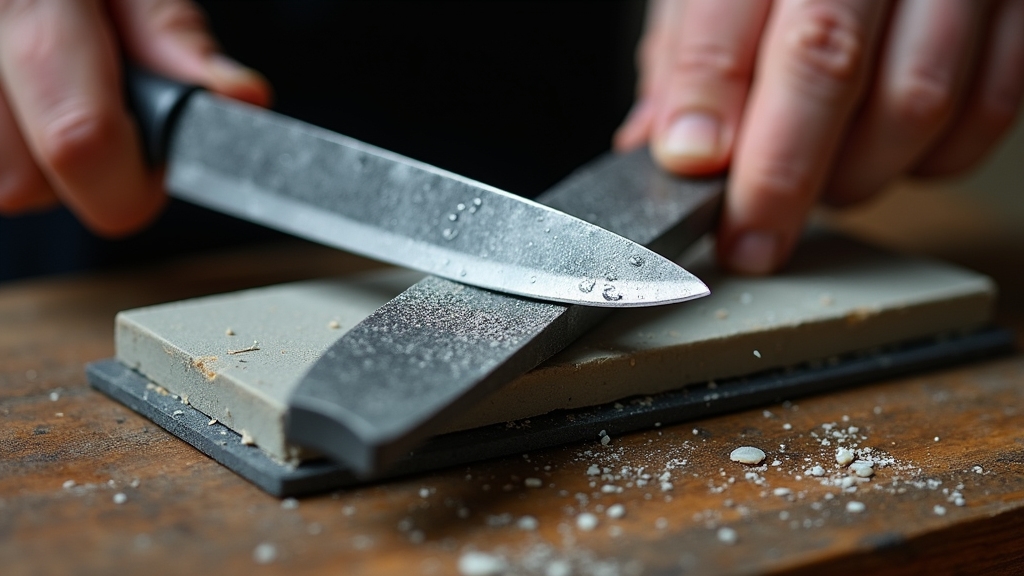
First things first, let’s get that sharpening stone ready. You’ll want to apply some water or cutting fluid to it. This step is super important because it helps with smooth abrasion and protects your knife from any damage. Submerge the wetstone in water until bubbles stop for optimal moistness. Remember to clean your sharpening stone regularly using a gentle brush to maintain its effectiveness.
Now, as you start sharpening, be sure to follow a systematic order. Keep that angle consistent, and remember to alternate your strokes. This way, you’ll evenly hone the flexible blade.
Don’t forget to keep an eye out for burr formation. It’s a common occurrence during sharpening, but you want to handle it carefully. Use finer grits to remove the burr, and you’ll be on your way to achieving a sharp, durable edge.
Stone Preparation and Setup
When you prepare your sharpening stone, soaking it properly is essential to achieve a razor-sharp edge on your fillet knife. Most water stones require soaking for 20 to 30 minutes to guarantee full saturation, which prevents overheating and promotes effective sharpening.
Regularly sharpening knives based on usage frequency helps prevent dullness and accidents. Always keep the stone surface moist during use to maintain consistent sharpening performance.
If you use splash and go stones, you can skip this soak but still keep the surface moist throughout. Before soaking, clean your stone to remove any debris. Proper cleaning and maintenance of sharpening tools ensure their longevity and effectiveness.
Next, secure your stone on a stable surface to prevent slipping during sharpening. This stability is crucial for safety and to maintain a consistent sharpening angle.
Set your knife at a consistent angle, around 20 degrees is ideal for fillet knives. Use a quarter or visualize halving a 45-degree angle for accuracy. Maintain this angle to ensure even sharpening from heel to tip, enhancing precision and safety throughout the process.
Sharpening Technique Order
Before you begin sharpening your fillet knife, position the blade tip on the stone and maintain a consistent angle between 20 and 25 degrees.
Start sharpening at the tip, moving the blade toward the handle to accommodate flexibility and cover the entire edge. This reverse technique helps ensure the tip is properly sharpened, which is often neglected in traditional methods.
Apply light to moderate pressure, increasing only during initial edge re-profiling.
Alternate sides every stroke to maintain symmetry and prevent uneven wear.
Use a downward-and-out, edge-leading stroke, ensuring smooth, continuous motions without sawing.
Focus on the tip, which dulls faster, with slightly more aggressive strokes.
Begin on a coarse or medium grit stone to shape the edge and create a burr, then progress to finer grits for polishing.
Decrease stroke counts per side as you refine the edge, maintaining consistent angles throughout.
Burr Formation and Removal
Although forming a burr might seem subtle, it’s a critical step in sharpening your flexible fillet knife. It signals that you’ve properly reshaped the edge.
You create the burr by maintaining a consistent edge angle, usually around 20 degrees, and applying controlled pressure with coarse grit. Once you feel the burr, carefully remove it by flipping the blade and using light swipes with finer grits or a leather strop to polish.
The burr forms as metal is pushed over to the opposite side during sharpening, indicating that enough material has been removed to form a new edge—this burr formation is essential before refining the edge. Using a whetstone allows better angle control to help form and detect the burr accurately.
| Aspect | Key Point |
|---|---|
| Metal Composition | Harder metals need more effort |
| Edge Angle | Consistency ensures burr formation |
| Pressure Control | Balanced pressure prevents damage |
| Burr Removal Tools | Leather strop and fine grit stones |
Techniques to Maintain Consistent Sharpening Angle
To maintain a consistent sharpening angle, you need reliable tools and deliberate technique that eliminate guesswork and prevent angle deviation.
Use guided sharpening systems or adjustable jigs that lock the blade at preset angles, typically between 15° and 20°, ensuring precise repeatability and improved safety similar to safety features found in kitchen appliances.
Physical angle guides, like coins under the blade, also provide tactile reference points.
Always position the blade centered in holders to balance bevel exposure on both sides.
Visual aids such as a Sharpie marker on the bevel help track angle consistency by revealing uneven contact.
Maintain steady hand pressure and slow, fluid strokes to avoid angle drift caused by wrist or arm instability.
Regularly check and reset your angle, and ensure your sharpening surface is flat and clean to prevent unintended angle changes during the process. Additionally, use light pressure when sharpening or honing to avoid dulling or damaging the blade, which helps maintain the blade’s sharpness and integrity.
Polishing and Honing to Perfect the Edge
Maintaining a consistent sharpening angle sets the foundation for refining your fillet knife’s edge through polishing and honing.
Begin polishing by progressing from coarse to fine grit whetstones or diamond stones, applying light pressure and alternating sides to guarantee evenness. It is important to maintain a consistent angle of 15-20 degrees during this process to achieve optimal results.
Use leather strops with polishing compounds to achieve a razor-sharp finish.
When honing, employ a honing rod with gentle pressure, alternating strokes on both sides to realign the edge without removing material.
Monitor the burr, a vital indicator of effective sharpening; remove it carefully using a fine-grit stone, alternating sides and gradually reducing pressure.
Consistently inspect the edge for smoothness and sharpness to confirm excellent results.
Tips for Maintaining Sharpness and Routine Care
When you handle your fillet knife with care after each use, you’ll extend its sharpness and overall lifespan considerably.
Always hand wash your knife immediately with warm water and mild soap, avoiding abrasive tools to protect the blade and handle. Dishwashers promote rust and damage the knife’s delicate edge, so avoid putting your fillet knife in the dishwasher.
Dry it thoroughly with an absorbent towel before storing.
Store your knife in a dedicated sheath in a dry, cool place to prevent corrosion and dulling.
Regularly sharpen your blade using medium to fine grit stones, maintaining the correct angle and forming a burr on both edges.
After cleaning, apply a light coat of food-grade oil to prevent rust without attracting dust.
Conduct routine inspections for damage and keep folding knife hinges lubricated to ensure smooth operation and safety.
Common Sharpening Mistakes to Avoid
Proper care and routine sharpening go hand in hand to keep your fillet knife performing at its best. Avoid using incorrect or inconsistent angles; maintain about a 12.5-degree angle with an angle guide to guarantee uniform sharpening.
Don’t apply excessive pressure or rush the process. Let the stone do the work for a clean edge. Always soak water stones properly, use appropriate grits in sequence, and clean the stone to prevent clogging.
Pay close attention to burr formation. Recognize and remove it by alternating sides and finish with leather stropping to polish. Avoid sharpening both sides simultaneously and ensure the knife and stone remain aligned and properly positioned.
Neglecting these details leads to uneven wear, weak edges, and reduced blade life. Regular honing is also crucial to maintain optimal performance and prolong the sharpness between full sharpenings.
Best Practices for Prolonging Fillet Knife Blade Life
To extend your fillet knife’s blade life, you need to clean it carefully using warm water and mild soap. Choosing a knife with a full tang handle ensures better balance and control, which contributes to less wear on the blade during use. Avoid harsh detergents or the dishwasher that can cause damage. Focus on the junction where the blade meets the handle, using a non-abrasive sponge to prevent scratching.
Carefully clean your fillet knife with warm water and mild soap to extend its blade life.
Dry the knife thoroughly to avoid rust. Store your knife in a dry sheath or case, ensuring both are moisture-free. Never leave it unprotected in a drawer. Avoid extreme temperatures that can weaken the blade.
Regularly sharpen your knife with a sharpening stone or honing rod, maintaining a consistent 15-20 degree angle. Use lubricant to prevent clogging. Apply food-grade oil to the blade to prevent corrosion, inspect for wear, and handle carefully to prolong its lifespan.
Frequently Asked Questions
Can I Use an Electric Sharpener for My Fillet Knife?
You shouldn’t use an electric sharpener for your fillet knife.
Most electric sharpeners are too aggressive and can damage the thin, flexible blades, causing chipping or uneven edges.
Instead, sharpen your fillet knife manually using a honing rod, whetstone, or a specialized sharpener designed for flexible or serrated blades.
This approach preserves the blade’s integrity and extends its lifespan, ensuring peak performance during use.
How Often Should I Sharpen My Fillet Knife With Regular Use?
You should sharpen your fillet knife every one to two months with regular use.
However, it’s smart to hone it before each major task to keep the edge aligned.
Pay attention to signs like slipping or dullness, which mean sharpening is needed sooner.
Remember, factors like blade quality and cutting surface affect frequency.
Adjust based on your knife’s performance and maintenance habits to maintain ideal sharpness.
Is There a Difference Between Sharpening Stainless Steel and Carbon Steel Fillet Knives?
Yes, there’s a difference.
Carbon steel sharpens faster and at lower angles (15–18°), letting you achieve a keen edge quickly. However, it rusts more easily.
Stainless steel needs higher angles (18–21°) and more effort due to its hardness and chromium content. But it holds its edge longer and resists corrosion.
You’ll want coarser stones and more passes for stainless, while carbon steel responds well to medium-to-fine grits and stropping.
Can Damaged or Chipped Fillet Knives Be Repaired by Sharpening?
Imagine a fillet knife with a small chip next to one with a deep crack. Sharpening can fix the first but not the second.
You can repair minor chips by grinding them out with coarse stones, progressing to finer grits for a polished edge.
However, large or deep damage often requires replacement, as excessive sharpening thins the blade and reduces flexibility.
Sharpen wisely to maintain performance and avoid worsening the damage.
What Is the Best Way to Test Sharpness After Sharpening a Fillet Knife?
To test sharpness after sharpening your fillet knife, start with the paper test. Slice standard printer paper cleanly without snagging.
Then, try the tomato test; your knife should effortlessly slice through skin without crushing.
For tactile feedback, carefully perform the thumb or fingernail test on the blade’s belly to check for bite.
Combining these methods gives you a reliable, safe assessment of sharpness to guarantee ideal performance.
Keep Practicing — Perfect Your Fillet Knife Sharpening Skills
Sharpening your fillet knife is like tuning a fine instrument.
Precision and care transform it into a tool of effortless grace.
By choosing the right tools, mastering the correct angle, and maintaining consistent technique, you’ll keep your blade razor-sharp and ready for any catch.
Avoid common pitfalls, polish with patience, and your knife will slice smoothly through time.
This ensures every fillet is a masterpiece of culinary craftsmanship.
Keep it sharp, keep it sharp.

